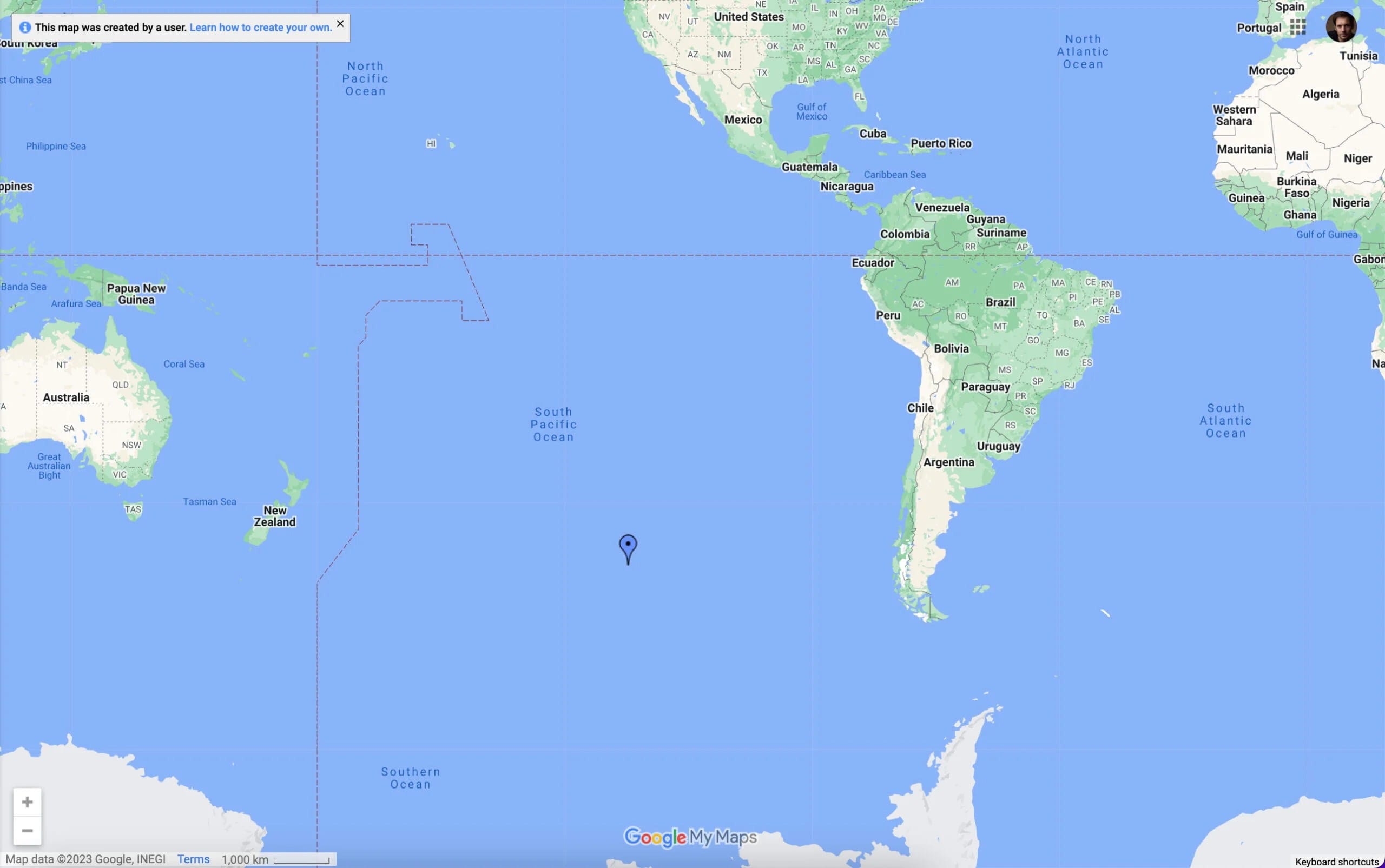Imagine a place so deeply isolated, so utterly removed from any trace of human civilization, that even the astronauts aboard the International Space Station are often closer to another human soul. This is Point Nemo, the oceanic pole of inaccessibility, a place where the coordinates 48°52.6′S 123°23.6′W mark not a place, but the profound absence of it.
A Geographic Anomaly: Defining the Void
Nestled within the vast expanse of the South Pacific Ocean, Point Nemo exists as a testament to the sheer scale of our planet’s watery heart. More than just a dot on a map, Point Nemo sits within the South Pacific Gyre, a massive rotating current notorious for trapping nutrient-poor water and contributing to the region’s sparse biodiversity.
To reach this point of utter solitude, one would need to journey over 2,688 kilometers (1,670 miles) from the nearest landmass, Motu Nui, a tiny islet in the Easter Island chain. Further still lie Ducie Island, part of the Pitcairn Islands, to the north, and Maher Island, a remote Antarctic outpost, to the south. This extreme isolation is precisely what earned Point Nemo its evocative name, a tribute to Captain Nemo, the solitary submarine captain from Jules Verne’s 20,000 Leagues Under the Sea, and a nod to the Latin meaning of “Nemo” – no one.
Discovered by Algorithm, Not Explorer: A Modern Paradox
Unlike the historical poles of inaccessibility, painstakingly reached by explorers battling unforgiving terrain, Point Nemo’s existence was unveiled not by intrepid adventurers, but by the quiet hum of a computer program in 1992. Hrvoje Lukatela, a Croatian-Canadian survey engineer, employed a bespoke algorithm to pinpoint this unique geographic anomaly, forever altering our understanding of ‘place’ in the digital age.
Point Nemo, therefore, embodies a fascinating paradox. It is a location defined by its absence—the farthest point from any landmass—yet its discovery and ongoing relevance are intricately linked to the interconnectedness of our modern world.
Life on the Edge: A Delicate Balance
The waters surrounding Point Nemo, while far from teeming with life, are not entirely barren. Despite the harsh conditions presented by the South Pacific Gyre, scientists believe certain resilient organisms, specially adapted to survive in this nutrient-deprived environment, likely persist. Bacteria, small crustaceans, and other extremophiles are thought to inhabit this unique ecosystem, providing valuable insights into the tenacity of life itself and offering a glimpse into the potential for life in other extreme environments, both on Earth and beyond.
A Silent Cemetery: Where Spacecraft Find Their Rest
The very remoteness that defines Point Nemo has also led to a somewhat melancholic distinction: it has become the chosen resting place for many of humanity’s spacefaring creations. Designated as a “spacecraft graveyard” due to its isolation and minimal maritime traffic, Point Nemo is where over 200 spacecraft, including the iconic MIR space station, have been intentionally guided to their watery graves.
This practice underscores the far-reaching consequences of human activities, even in the most seemingly untouched corners of our planet. The remnants of these technological marvels, scattered across the ocean floor, serve as a silent—and some might say, eerie—testament to our enduring legacy in the cosmos.
## Point Nemo: A Frontier of Questions
While Point Nemo might appear as a desolate and insignificant speck on the map, it holds a strange allure, sparking curiosity and prompting profound questions about our place in the vastness of the universe.
How do ecosystems function in such extreme isolation? Ongoing research into the unique lifeforms thriving in Point Nemo’s challenging environment could provide invaluable insights into the resilience of life and the potential for life in other extreme environments, both on Earth and beyond.
What is the long-term impact of human activities, even in the most remote corners of the planet? The presence of the “spacecraft graveyard” at Point Nemo raises important questions about our responsibility for managing the debris of our technological advancements.
How does the discovery and understanding of places like Point Nemo reshape our perception of geography and belonging in an increasingly interconnected world? As we continue to explore and define the far reaches of our planet, places like Point Nemo challenge us to reconsider our relationship with the physical world and the implications of our presence—and absence—within it.
Point Nemo, despite its remoteness and desolation, is far from being simply a vacant point in the ocean. It is a place that continues to captivate our imagination, prompting reflection on the delicate balance of life on Earth, the consequences of our technological advancements, and the very nature of exploration and discovery in the 21st century.
## Where is Point Nemo on Google Maps?
If you’re hoping to find Point Nemo on Google Maps, expecting to zoom in on a desolate island or a swirling vortex, prepare for disappointment. The reality is far more subtle, far more intriguing. Point Nemo, the oceanic pole of inaccessibility, is not a tangible landmark; it is a concept, a point of convergence for intricate geographic calculations.
You won’t find street views, tourist reviews, or even blurry satellite images. Point Nemo, in all its desolate glory, is simply a patch of open ocean, indistinguishable from the countless other patches surrounding it. You’ll need to content yourself with punching in those evocative coordinates—48°52.6′S 123°23.6′W—and letting your imagination take flight.
Are You Allowed to Go to Point Nemo?
The short answer is: yes. There are no maritime laws preventing you from mounting an expedition to this remote oceanic pole. However, the more practical answer is far more complicated, fraught with logistical nightmares and potential hazards.
Point Nemo’s extreme remoteness—the very factor that defines it—makes reaching it a herculean task. A journey to Point Nemo requires meticulous planning, significant resources, and a crew willing to brave the perils of weeks, if not months, at sea. You’ll be contending with unpredictable weather patterns, towering waves, and the psychological toll of extreme isolation.
Despite these challenges, a handful of intrepid souls have successfully made the pilgrimage to Point Nemo. In 2015, a team of four rowers completed an epic 120-day journey, battling unforgiving conditions to reach this elusive destination. More recently, a scientific research team embarked on an expedition to study the unique marine life and collect data on this largely unexplored region.
These daring ventures highlight the enduring human spirit of exploration, the drive to push boundaries and venture beyond the familiar. However, it’s crucial to remember that Point Nemo is not your average tourist destination. It’s a testament to the raw power and vastness of our planet, a place that demands respect and careful consideration.
## Who are the Closest Humans to Point Nemo?
It might seem counterintuitive, but the closest humans to Point Nemo are not hardy sailors braving the high seas, but astronauts orbiting hundreds of miles above the Earth. Yes, the inhabitants of the International Space Station (ISS), those pioneers of space exploration, can claim the peculiar distinction of being Point Nemo’s nearest neighbors.
This intriguing reality underscores the interconnectedness of our world, even in its most extreme points. While Point Nemo remains a symbol of geographic isolation, even this remote location is touched by human presence, albeit from a vantage point far removed from our usual terrestrial perspective.
There’s also the rockefeller tree tragedy and the villisca axe house.
- Medieval Houses: A Social History Through Architecture - April 29, 2025
- Unlock Senior Perks: How Old is a Senior Citizen?Complete Guide - April 29, 2025
- Happy Patients: Tech Solutions for Better Healthcare - April 29, 2025
















